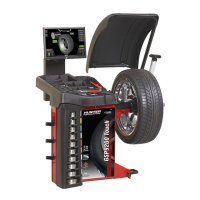INTRODUCTION TO BALANCING 13
2.2 SmartWeight Balancing
Technology®
SmartWeight Balancing Technology® is not a procedure.
Rather, it is a technology that measures the forces of
couple side-to-side shimmy and static up-and-down
shake and computes the correction weight required to
reduce these forces. This reduces the amount of weight
used, reduces time, reduces check spins, “chasing
weights”, and saves shop time and money.
SmartWeight Balancing Technology® can reduce the
number of steps in the balancing process. Not only does
SmartWeight Balancing Technology® give the customer
a better riding vehicle, it also helps the environment by
using less corrective weight.
Static and non-rounding modes are eliminated to simplify
operation. Always enter at least two weight positions
during wheel measurement in SmartWeight® balancing
mode. All other functions are identical to the traditional
balancing method.
Static and Dynamic Imbalance Sensitivity
As a general rule of thumb, to achieve the best balance
on an average sized tire and wheel assembly Residual
static imbalance should be less than 1/4 ounce (7 grams).
Residual couple imbalance should be less than
3/4 ounce (21 grams).
• Residual couple imbalance is preferred over
remaining static imbalance.
• It takes much more residual couple imbalance weight
to cause a vibration than the same amount of static
imbalance correction weight.
• The larger the diameter used for weight placement,
the smaller the amount of correction weight is
required for static correction.
• The wider the distance between the two weight
placement locations, the smaller the amount of
correction weight is required for couple correction.
• If static balance is the only option, always verify that
the remaining couple residual imbalance is within
acceptable tolerance. This can only be verified using
SmartWeight® balancing.
SmartWeight® balancing performs this check
automatically.
Dynamic balancers direct the operator to place correction
weights on the inside and outside correction locations
of the rim, or a single weight away from the center of
the wheel, so that both imbalance shake (static) and
imbalance wobble (couple) will be eliminated.
STATIC IMBALANCE (SHAKE)
+ COUPLE IMBALANCE (SHIMMY)
= DYNAMIC IMBALANCE
TOP VIEW
IMBALANCE
FORCE
TERAL TWIST
OR SHIMMY)
STATIC
IMBALANCE
FORCE
(SHAKE)
Figure 25.

